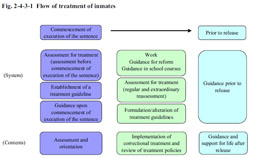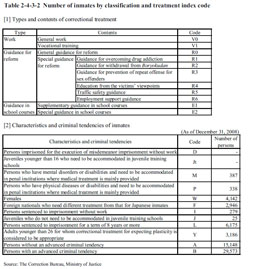| Previous Next Index Image Index Year Selection | |
|
|
1 Overview of treatment (1) Correctional treatmentFig. 2-4-3-1 shows the flow of treatment of inmates in penal institutions. In accordance with the Penal Detention Facilities Act, the treatment of inmates aims to enable inmates to be more aware of themselves according to their individual characteristics and environment, arouse their motivation to reform and rehabilitate themselves, and foster their ability to adapt to a social life while respecting their human rights. Correctional treatment has been carried out mainly through work, guidance for reform, and guidance in school courses. Fig. 2-4-3-1 Flow of treatment of inmates Correctional treatment is implemented based on treatment guidelines that specify the goals, basic content, and methods used in correctional treatment of the individual inmates. Inmates are classified into groups as necessary in carrying out the most effective treatment for them. This classification is known as the group classification of inmates.Formulation of treatment guidelines and group classification are based on assessments for treatment (assessment of personal characteristics and the environments of inmates) that utilize expertise and technology from fields such as medicine, psychology, education, and sociology. There are two types of assessment, namely an assessment at the commencement of execution of the sentence and a reassessment (regular/extraordinary). In addition, special institutions are designated assessment centers within each Regional Correction Headquarters, and make detailed assessments on [1] finally sentenced and newly admitted juvenile inmates younger than 16 whose term of imprisonment is three months or more, [2] finally sentenced and newly admitted male inmates aged 16-19 whose term of imprisonment is one year or more but without a previous imprisonment history (refers to history of having served a sentence in a penal institution or juvenile training school; hereinafter the same in this subsection) (excluding those classified into Class F (foreign nationals who need different treatment from that for Japanese inmates)), [3] finally sentenced and newly admitted male inmates aged 20-25 whose term of imprisonment is 1.5 years or more but without a previous imprisonment history (excluding those classified into Class F and Boryokudan members), and [4] finally sentenced and newly admitted inmates for whom detailed assessments are needed to provide special guidance for reform (inmates for sex offenses, etc.). A treatment index is specified for respective sentenced inmates according to the results of their assessment for treatment. A treatment index is organized in terms of both the type and content of the correctional treatment and the characteristics and criminal tendencies of the actual inmate. The penal institution in which the inmate is placed and the priority of the treatment that suits the inmate are then determined using the treatment index. Table 2-4-3-2 shows the number of inmates by classification and treatment index code. Table 2-4-3-2 Number of inmates by classification and treatment index code (2) Alleviation of restrictions and privilege measuresAlleviation of restrictions is a system used to gradually alleviate restrictions on inmates’ daily lives and activities to cultivate their self-control and self-reliance, according to what they have achieved while serving their sentence. Inmates are designated as Level 1 to Level 4 according to the likelihood of them becoming more motivated to reform and rehabilitate themselves and developing the capability of leading a social life. Based on the result of examination of subject penal institutions (refers to 76 main penal institutions, eight branch prisons, and the four large-scale branch detection houses in Sapporo, Yokohama, Saitama, and Kokura; hereinafter the same in this subsection), as of April 10, 2009, 493 inmates (0.7%) in these institutions were designated as Level 1, 3,087 (4.7%) Level 2, 54,096 (81.5%) Level 3, and 3,405 (5.1%) Level 4, while 5,256 (7.9%) had no designation (Source: The Correction Bureau, Ministry of Justice). Privilege measures is a system used to provide inmates leading sober, sensible lives with better conditions by furnishing more opportunities to come in contact with the outside world and expanding the range of self-supplied articles, etc. The use of this system is based on a relatively short-term assessment of inmates’ attitudes toward their sentences and with the aim of aiding inmates to make further efforts toward their reformation/rehabilitation. Inmates are designated as Level 1 to 5 according to an assessment of their attitudes toward their sentences, the order being from good to bad. The results of examination of the subject penal institutions, as of April 10, 2009, revealed that 226 inmates (0.3%) in the institutions were designated as Level 1, 5,956 (9.0%) Level 2, 29,731 (44.8%) Level 3, 7,795 (11.8%) Level 4, and 9,486 (14.3%) Level 5, while 13,130 (19.8%) had no designation (Source: The Correction Bureau, Ministry of Justice). (3) Day leave and furloughs Day leave and furloughs is a system used to allow inmates who meet certain requirements, such as being capable of receiving treatment in an open facility, to temporarily leave a penal institution without being accompanied by an institution official if they need to do certain business, etc. Day leave is limited to one-day trips and furloughs to seven days maximum. Day leave and furloughs can be granted when considered necessary for an inmate to spend some time out of the institution to discuss securing a residence or employment after release with someone outside or to maintain/adjust family relationships, or if the need exists to visit a volunteer probation officer or others related to their rehabilitation. The system is expected to contribute to the rehabilitation of inmates by providing them with the opportunity to prepare for a smooth reintegration into society. |

